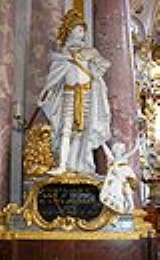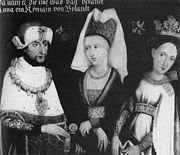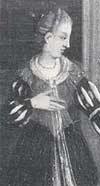
Louis II, Duke of Bavaria
Encyclopedia

Heidelberg
-Early history:Between 600,000 and 200,000 years ago, "Heidelberg Man" died at nearby Mauer. His jaw bone was discovered in 1907; with scientific dating, his remains were determined to be the earliest evidence of human life in Europe. In the 5th century BC, a Celtic fortress of refuge and place of...
, he was a son of duke Otto II
Otto II Wittelsbach, Duke of Bavaria
Otto II of Bavaria was the Duke of Bavaria and Count Palatine of the Rhine . He was a son of Louis I and Ludmilla of Bohemia and a member of the Wittelsbach dynasty.- Biography :...
and Agnes of the Palatinate
Agnes of the Palatinate
Agnes of the Palatinate was a daughter of Henry V, Count Palatine of the Rhine and his first wife Agnes, daughter of Conrad, Count Palatine of the Rhine . Agnes was Duchess of Bavaria by her marriage to Otto II Wittelsbach, Duke of Bavaria....
. She was a daughter of the Welf Henry V, Count Palatine of the Rhine
Henry V, Count Palatine of the Rhine
Henry was count palatine of the Rhine from 6 August 1195 to 1213.Henry was the eldest son of Duke Henry the Lion, from his marriage to Matilda, eldest daughter of King Henry II of England and Eleanor of Aquitaine. He grew up in England and became count palatine of the Rhine through his 1193...
, her grandfathers were Henry XII the Lion
Henry the Lion
Henry the Lion was a member of the Welf dynasty and Duke of Saxony, as Henry III, from 1142, and Duke of Bavaria, as Henry XII, from 1156, which duchies he held until 1180....
and Conrad of Hohenstaufen
Conrad of Hohenstaufen
Conrad of Hohenstaufen was the first hereditary Count Palatine of the Rhine.His parents were Frederick II of Swabia , Duke of Swabia, and his second wife Agnes of Saarbrücken...
.
Biography
The young Louis supported in 1246 his brother-in-law King Conrad IV of GermanyConrad IV of Germany
Conrad IV was king of Jerusalem , of Germany , and of Sicily .-Biography:...
against the usurpation of Heinrich Raspe
Heinrich Raspe
Henry Raspe succeeded Hermann II as Landgrave of Thuringia in central Germany in 1241; he later was elected anti-king in 1246–1247 in opposition to Conrad IV of Germany....
. In 1251 Louis was at war again against the bishop of Regensburg.
Louis succeeded his father Otto as Duke of Bavaria in 1253. When the Wittelsbach
Wittelsbach
The Wittelsbach family is a European royal family and a German dynasty from Bavaria.Members of the family served as Dukes, Electors and Kings of Bavaria , Counts Palatine of the Rhine , Margraves of Brandenburg , Counts of Holland, Hainaut and Zeeland , Elector-Archbishops of Cologne , Dukes of...
country was divided in 1255 among Otto's sons, Louis received the Palatinate and Upper Bavaria
Upper Bavaria
Upper Bavaria is one of the seven administrative regions of Bavaria, Germany.- Geography :Upper Bavaria is located in the southern portion of Bavaria, and is centered around the city of Munich. It is subdivided into four regions : Ingolstadt, Munich, Bayerisches Oberland , and Südostoberbayern...
, while his brother duke Henry XIII of Bavaria
Henry XIII, Duke of Bavaria
Henry XIII of Bavaria, member of the Wittelsbach dynasty was Duke of Lower Bavaria. As Duke of Lower Bavaria he is also called Henry I.- Family :...
received Lower Bavaria
Lower Bavaria
Lower Bavaria is one of the seven administrative regions of Bavaria, Germany, located in the east of the state.- Geography :Lower Bavaria is subdivided into two regions - Landshut and Donau-Wald. Recent election results mark it as the most conservative part of Germany, generally giving huge...
. This partition was against the law and therefore caused the anger of the bishops in Bavaria who allied themselves with king Otakar II of Bohemia in 1257. In August 1257 Ottokar invaded Bavaria, but Louis and Henry managed to repulse the attack. It was one of the rare concerted and harmonious actions of the two brothers, who often argued.
Louis resided in Munich
Alter Hof
The Alte Hof in the center of Munich is the former imperial residence of Louis IV, Holy Roman Emperor and consists of five wings Burgstock, Zwingerstock, Lorenzistock, Pfisterstock and Brunnenstock....
and Heidelberg Castle
Heidelberg Castle
The Heidelberg Castle is a famous ruin in Germany and landmark of Heidelberg. The castle ruins are among the most important Renaissance structures north of the Alps....
. As one of the Prince-elector
Prince-elector
The Prince-electors of the Holy Roman Empire were the members of the electoral college of the Holy Roman Empire, having the function of electing the Roman king or, from the middle of the 16th century onwards, directly the Holy Roman Emperor.The heir-apparent to a prince-elector was known as an...
s of the empire he was strongly involved in the royal elections for forty years. During the German interregnum
Interregnum
An interregnum is a period of discontinuity or "gap" in a government, organization, or social order...
after King William's death in 1256 Louis supported King Richard of Cornwall
Richard, 1st Earl of Cornwall
Richard of Cornwall was Count of Poitou , 1st Earl of Cornwall and German King...
. Together with his brother, Louis also aided his young Hohenstaufen
Hohenstaufen
The House of Hohenstaufen was a dynasty of German kings in the High Middle Ages, lasting from 1138 to 1254. Three of these kings were also crowned Holy Roman Emperor. In 1194 the Hohenstaufens also became Kings of Sicily...
nephew Conradin
Conradin
Conrad , called the Younger or the Boy, but usually known by the diminutive Conradin , was the Duke of Swabia , King of Jerusalem , and King of Sicily .-Early childhood:Conradin was born in Wolfstein, Bavaria, to Conrad...
in his duchy of Swabia
Swabia
Swabia is a cultural, historic and linguistic region in southwestern Germany.-Geography:Like many cultural regions of Europe, Swabia's borders are not clearly defined...
, but it was not possible to enforce Conradin's election as German king. As a result of his support for the Hohenstaufen, Louis was banned by the pope in 1266. In 1267 when his nephew crossed the Alps with an army, Louis accompanied Conradin only to Verona
Verona
Verona ; German Bern, Dietrichsbern or Welschbern) is a city in the Veneto, northern Italy, with approx. 265,000 inhabitants and one of the seven chef-lieus of the region. It is the second largest city municipality in the region and the third of North-Eastern Italy. The metropolitan area of Verona...
. After the young prince's execution in Naples
Naples
Naples is a city in Southern Italy, situated on the country's west coast by the Gulf of Naples. Lying between two notable volcanic regions, Mount Vesuvius and the Phlegraean Fields, it is the capital of the region of Campania and of the province of Naples...
in 1268, Louis inherited some of Conradin's possessions in Swabia
Swabia
Swabia is a cultural, historic and linguistic region in southwestern Germany.-Geography:Like many cultural regions of Europe, Swabia's borders are not clearly defined...
and supported the election of the Habsburg
Habsburg
The House of Habsburg , also found as Hapsburg, and also known as House of Austria is one of the most important royal houses of Europe and is best known for being an origin of all of the formally elected Holy Roman Emperors between 1438 and 1740, as well as rulers of the Austrian Empire and...
Rudolph I
Rudolph I of Germany
Rudolph I was King of the Romans from 1273 until his death. He played a vital role in raising the Habsburg dynasty to a leading position among the Imperial feudal dynasties...
against Ottokar II in 1273. On 26 August 1278 the armies of Rudolph and Louis met Otakar's forces on the banks of the River March in the Battle of Dürnkrut and Jedenspeigen
Battle of Dürnkrut and Jedenspeigen
The Battle on the Marchfeld at Dürnkrut and Jedenspeigen took place on August 26, 1278 and was a decisive event for the history of Central Europe for the following centuries...
where Otakar was defeated and killed. In 1289 the electoral dignity
Prince-elector
The Prince-electors of the Holy Roman Empire were the members of the electoral college of the Holy Roman Empire, having the function of electing the Roman king or, from the middle of the 16th century onwards, directly the Holy Roman Emperor.The heir-apparent to a prince-elector was known as an...
of Bavaria passed to Bohemia again, but Louis remained an elector as Count Palatine of the Rhine. After Rudolph's death in 1291 Louis could not enforce the election of his Habsburg brother-in-law Albert I
Albert I of Germany
Albert I of Habsburg was King of the Romans and Duke of Austria, the eldest son of German King Rudolph I of Habsburg and his first wife Gertrude of Hohenburg.-Life:...
against Adolf of Nassau
Adolf of Nassau-Weilburg
Adolf was the King of Germany from 1292 until 1298. Though his title in his lifetime was Rex Romanorum , he is usually known as Adolf of Nassau...
.
Louis died at Heidelberg. His eldest surviving son Rudolf
Rudolf I, Duke of Bavaria
Rudolf I of Bavaria , a member of the Wittelsbach dynasty, was Duke of Bavaria and Count Palatine of the Rhine...
succeeded him, with Adolf of Nassau becoming his father-in-law a few months later. Louis was buried in the crypt of Fürstenfeld Abbey
Fürstenfeld Abbey
Fürstenfeld Abbey is a former Cistercian monastery in Fürstenfeldbruck in Bavaria, Germany.It is situated about 25 km north-west of Munich. The abbey was one of the household monasteries of the Wittelsbachs...
.
Family and children

The execution of Marie of Brabant
He had his first wife Marie of BrabantMarie of Brabant (1226-1256)
Marie of Brabant was a daughter of Henry II, Duke of Brabant and Marie of Hohenstaufen. She married Louis II, Duke of Bavaria, being the first of three wives.- Family :...
—a daughter of Henry II, Duke of Brabant
Henry II, Duke of Brabant
Henry II of Brabant was Duke of Brabant and Lothier after the death of his father Henry I in 1235...
and Marie of Hohenstaufen
Marie of Hohenstaufen
Marie of Hohenstaufen was a member of the powerful Hohenstaufen dynasty of German kings which lasted from 1138 to 1254. She is also known to history as Maria of Swabia....
— executed in Donauwörth
Donauwörth
Donauwörth is a city in the German State of Bavaria , in the region of Swabia . It is said to have been founded by two fisherman where the Danube and Wörnitz rivers meet...
in 1256 due to mistaken suspicion of adultery; back in those days the punishment for an adulterous wife was beheading. Any actual guilt on her part could never be validated. As expiation Louis founded the Cistercian friary Fürstenfeld Abbey
Fürstenfeld Abbey
Fürstenfeld Abbey is a former Cistercian monastery in Fürstenfeldbruck in Bavaria, Germany.It is situated about 25 km north-west of Munich. The abbey was one of the household monasteries of the Wittelsbachs...
(Fürstenfeldbruck) near Munich.
Different sources tell varying tales about how this terrible mistake could happen in the first place: In 1256 Louis had been away from home for an extended time, due to his responsibilities as a sovereign in the area of the Rhine. His wife wrote two letters, one to her husband, and another to the earl of Kyburg at Hunsrück, a vassal of Louis. Details about the actual content of the second letter vary, but according to the chroniclers the messenger who carried the letter to Ludwig had been given the wrong one, and Louis came to the conclusion that his wife had a secret love affair.
Over time a great many tales of folklore sprang up around Louis' bloody deed, most of them written long after his death: Ballad-mongers embellished the tale into a murderous frenzy, during which Louis allegedly not only killed his wife after having ridden home for five days and nights, but also stabbed the messenger who brought him the wrong letter, then upon entering his castle stabbed his own castellan and a court lady and threw his wife's maid from the battlements, before he massacred his wife either by stabbing her or cutting off her head.
Several more restrained chronicles support the account of Marie's execution on January 18, 1256 in Donauwörth at castle Mangoldstein by ducal decree for alleged adultery, but nothing beyond that.
Later marriages

Anna of Glogau
Anna of Glogau was the eldest child of Konrad I, Duke of Silesia-Glogau and his first wife Salome of Greater Poland. Anna was a member of the House of Piast.- Family :...
. They had the following children:
- Maria (b. 1261), a nun in MarienburgMarienburg-The historical German names of these places:*Ordensburg Marienburg , the large brick castle built by the Teutonic Knights**Malbork, Poland, site of the Ordensburg Marienburg, formerly Marienburg in Westpreußen and during World War II, Nazi Stalag XX-B for enlisted men*Alūksne, Latvia*Feldioara,...
abbey. - Ludwig (13 September 1267–23 November 1290, killed at a tournament at NurembergNurembergNuremberg[p] is a city in the German state of Bavaria, in the administrative region of Middle Franconia. Situated on the Pegnitz river and the Rhine–Main–Danube Canal, it is located about north of Munich and is Franconia's largest city. The population is 505,664...
.
He married his third wife Matilda of Habsburg
Matilda of Habsburg
Matilda of Habsburg or Melchilde was the eldest daughter of Rudolph I of Germany and Gertrude of Hohenburg...
, one of king Rudolph
Rudolph I of Germany
Rudolph I was King of the Romans from 1273 until his death. He played a vital role in raising the Habsburg dynasty to a leading position among the Imperial feudal dynasties...
's daughters, on 27 October 1273. Their children were:
- Agnes (ca. 1267/77–1345), married to:
- 1290 in DonauwörthDonauwörthDonauwörth is a city in the German State of Bavaria , in the region of Swabia . It is said to have been founded by two fisherman where the Danube and Wörnitz rivers meet...
Landgrave Henry II of Hesse; - 1298/1303 Heinrich I "Ohneland" ("Lackland"), Margrave of Brandenburg.
- 1290 in Donauwörth
- Rudolf IRudolf I, Duke of BavariaRudolf I of Bavaria , a member of the Wittelsbach dynasty, was Duke of Bavaria and Count Palatine of the Rhine...
(4 October 1274, Basle–12 August 1319). - Mechthild (1275–28 March 1319, LüneburgLüneburgLüneburg is a town in the German state of Lower Saxony. It is located about southeast of fellow Hanseatic city Hamburg. It is part of the Hamburg Metropolitan Region, and one of Hamburg's inner suburbs...
), married 1288 to Duke Otto II of Brunswick-LüneburgOtto II, Duke of Brunswick-LüneburgOtto II, Duke of Brunswick and Lüneburg , also known as Otto the Strict , came from the House of Welf and was Prince of Lüneburg from 1277 to 1330.-Life:...
. - Ludwig IV (1 April 1282, MunichMunichMunich The city's motto is "" . Before 2006, it was "Weltstadt mit Herz" . Its native name, , is derived from the Old High German Munichen, meaning "by the monks' place". The city's name derives from the monks of the Benedictine order who founded the city; hence the monk depicted on the city's coat...
–11 October 1347, Puch (now a district of FürstenfeldbruckFürstenfeldbruckFürstenfeldbruck is a town in Bavaria, Germany. It is the capital of the district of Fürstenfeldbruck. it has a population of 35,494. Since the 1930s, Fürstenfeldbruck has had an air force base....
)).
Louis II was succeeded by his oldest son Rudolf.
Ancestry
External links
- German wiki entry for Ludwig II. (Ludwig der Strenge)
- Genealogy of Ludwig II. (compilation of various sources, in German)

